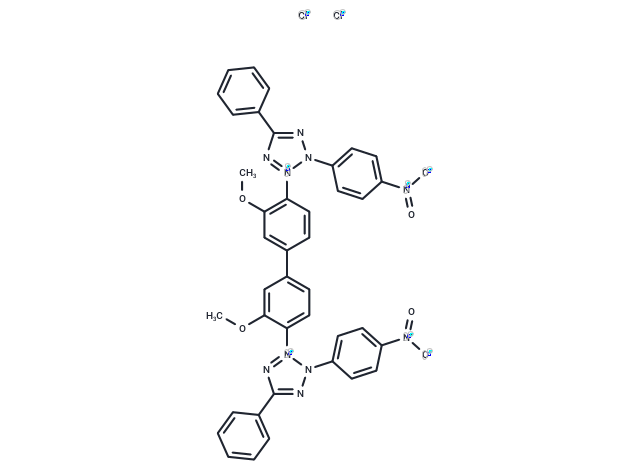Shopping Cart
Remove All Your shopping cart is currently empty
Your shopping cart is currently empty
Nitro blue tetrazolium chloride (NBT), an NADPH-diaphorase substrate (IC50 = 3-4 M) and well-known scavenger of superoxide anions, competitively inhibits nitric oxide synthase. Additionally, NBT, as a substrate for dehydrogenases, is used with the alkaline phosphatase substrate BCIP in western blotting and immunohistological staining procedures.

| Pack Size | Price | USA Warehouse | Global Warehouse | Quantity |
|---|---|---|---|---|
| 500 mg | $42 | In Stock | In Stock | |
| 1 g | $56 | In Stock | In Stock | |
| 1 mL x 10 mM (in DMSO) | $30 | In Stock | In Stock |
| Description | Nitro blue tetrazolium chloride (NBT), an NADPH-diaphorase substrate (IC50 = 3-4 M) and well-known scavenger of superoxide anions, competitively inhibits nitric oxide synthase. Additionally, NBT, as a substrate for dehydrogenases, is used with the alkaline phosphatase substrate BCIP in western blotting and immunohistological staining procedures. |
| Targets&IC50 | Nitric oxide (NO):3-4 M |
| Cell Research | Instructions I. Solution preparation 1. NBT stock solution: Dissolve NBT in distilled water or an appropriate buffer (e.g. 70% dimethylformamide, DMF). Common concentration: 50–75 mg/mL. The stock solution should be stored in the dark at -20°C. BCIP stock solution: Dissolve BCIP in dimethylformamide (DMF) or water. Common concentration: 50 mg/mL. Store at -20°C and protect from light. 2. Working solution: Prepare the working solution freshly immediately before the experiment, add NBT and BCIP to an appropriate detection buffer (e.g. Tris buffered saline (TBS), pH 9.5), and the final concentrations are as follows: NBT: 0.1–0.5 mg/mL; BCIP: 0.05–0.3 mg/mL. Note: The prepared working solution should be used immediately to avoid decreased activity. II. Operation steps 1. Western Blotting: (1) After transferring the protein to a membrane (such as nitrocellulose or PVDF membrane), use a blocking buffer (such as TBS containing 5% BSA) to block nonspecific binding sites. (2) Add a primary antibody against the target protein and then incubate the membrane with a secondary antibody conjugated to alkaline phosphatase. (3) Wash thoroughly to remove unbound antibody. (4) Add freshly prepared NBT/BCIP working solution. (5) Incubate in the dark at room temperature until the desired degree of color development is achieved (usually 5–30 minutes). (6) Terminate the reaction with water or Tris-EDTA buffer and save the results. 2. Immunohistochemistry (IHC): (1) Fix the tissue sections and block nonspecific binding with a blocking buffer. (2) Incubate the tissue sections with a primary antibody specific for the target protein and then use a secondary antibody conjugated to alkaline phosphatase. (3) Wash the sections thoroughly. (4) Add NBT/BCIP working solution and observe the color development reaction. (5) After the color development reaches the desired intensity, terminate the reaction with water. If necessary, the sections can be contrast stained (such as hematoxylin for nuclear staining). 3. Enzyme activity detection: (1) NBT is often used to detect dehydrogenase activity. Dehydrogenase reduces NBT to produce a dark blue insoluble formazan product. (2) Add appropriate co-substrate (such as NADH or FADH) to the enzyme reaction buffer. (3) Add NBT and monitor the colorimetric change (using a spectrophotometer or visual observation). Precautions: 1. Photosensitivity: NBT is light-sensitive. During the experiment, its exposure to light should be minimized and stored away from light. 2. Operational safety: Avoid direct contact with skin or inhalation. Wear appropriate personal protective equipment (PPE) during the experiment. 3. Optimize experimental conditions: Reaction time and reagent concentration should be optimized according to specific experimental conditions to obtain the best results. 4. Compatibility: The NBT/BCIP substrate system specifically detects alkaline phosphatase activity. Other enzymes or reagents that may interfere with this detection system should be avoided in the experimental system. |
| Synonyms | NBT |
| Molecular Weight | 817.64 |
| Formula | C40H30Cl2N10O6 |
| Cas No. | 298-83-9 |
| Smiles | [Cl-].[Cl-].COC1=CC(=CC=C1[N+]1=NC(=NN1C1=CC=C(C=C1)[N+]([O-])=O)C1=CC=CC=C1)C1=CC(OC)=C(C=C1)[N+]1=NC(=NN1C1=CC=C(C=C1)[N+]([O-])=O)C1=CC=CC=C1 |
| Relative Density. | 1.5521 g/cm3 (Estimated) |
| Color | Yellow |
| Appearance | Solid |
| Storage | keep away from direct sunlight,store at low temperature | Powder: -20°C for 3 years | In solvent: -80°C for 1 year | Shipping with blue ice/Shipping at ambient temperature. | ||||||||||||||||||||||||||||||||||||||||
| Solubility Information | DMSO: 9 mg/mL (11.01 mM), Sonication and heating are recommended. 70%DMF: 100 mg/mL (122.3 mM), Sonication is recommended. | ||||||||||||||||||||||||||||||||||||||||
| In Vivo Formulation | 10% DMSO+40% PEG300+5% Tween-80+45% Saline: 0.5 mg/mL (0.61 mM), Sonication is recommeded. Please add the solvents sequentially, clarifying the solution as much as possible before adding the next one. Dissolve by heating and/or sonication if necessary. Working solution is recommended to be prepared and used immediately. The formulation provided above is for reference purposes only. In vivo formulations may vary and should be modified based on specific experimental conditions. | ||||||||||||||||||||||||||||||||||||||||
Solution Preparation Table | |||||||||||||||||||||||||||||||||||||||||
DMSO/70%DMF
70%DMF
| |||||||||||||||||||||||||||||||||||||||||
| Size | Quantity | Unit Price | Amount | Operation |
|---|

Copyright © 2015-2026 TargetMol Chemicals Inc. All Rights Reserved.